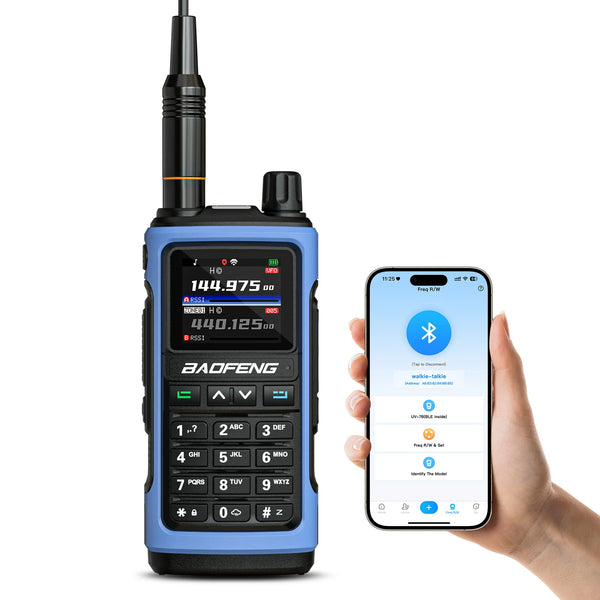"My radio is on the same frequency—I can hear others, but why can't they hear me?" In radio communications, this problem frequently arises, and the most common solution is: "Check if your CTCSS/DCS codes match."
But what exactly are CTCSS/DCS? And why do mismatched codes disrupt communication? This article will break down the principles, giving you a complete understanding of how sub-audible tones work.
CTCSS & DCS
CTCSS (Continuous Tone-Coded Squelch System) is an analog signaling technology. It embeds a sub-audible tone (67.0Hz-254.1Hz) into transmissions. Receivers only unmute when detecting an exact frequency match to their preset CTCSS tone.
The industry standard provides 38-50 predefined CTCSS frequencies (e.g., 100.0Hz). While effective for basic filtering, this analog system shows limitations in noisy environments.
As the digital evolution of CTCSS, DCS uses binary coding (e.g., D023N) with 83-210 code variations (vendor-dependent).
Both systems require identical codes (tone/frequency for CTCSS, digital sequence for DCS) between communicating devices. Non-matching signals are automatically filtered, ensuring clean channel access. Below is a comparison table of the two privacy codes
| Features | CTCSS | DCS |
|---|---|---|
| Full name | Continuous Tone-Coded Squelch System | Digital-Coded Squelch |
| Signal type | Continuous low-frequency analog signal | Digital coded signal |
| Anti-interference performance | Average (susceptible to noise) | Stronger (digital error correction) |
| Frequency range | 67.0Hz - 254.1Hz | No fixed frequency, digital coding (such as D023N) |
| Power consumption | Lower | Slightly higher |
| Number of codes | 38-50 (standard frequency points) | 104-210 (different manufacturers) |
| How it works |
● A low-frequency sine wave with a fixed frequency (such as 100.0Hz) is superimposed during transmission ● The receiver will open the squelch only when it detects the matching frequency ● An analog matching mechanism similar to "key and lock" |
● 23-bit digital code is embedded during transmission (such as D754I) ● The receiving end must fully match the code before responding ● Forward error correction technology is used, which has stronger anti-interference ability |
Benefits of Privacy Codes
For unlicensed radio users, channel interference poses a significant challenge. When multiple users share the same frequency, chaotic communications can reduce efficiency and cause confusion. This is an important reason why CTCSS/DCS tone codes were developed.
By configuring a specific CTCSS or DCS code, your radio attaches a sub-audible tone to transmissions. Only radios with matching codes will unmute and play your audio, effectively filtering out unwanted signals.
Key Notes:
Tone codes ≠ encryption! They simply act as communication filters:
• Same channel + same code: Normal communication
• Unmatched/no-code users may still hear you (device-dependent)
• For true privacy, encryption features are required
Steps to Set Up CTCSS /DCS
(1) Manual setting (Baofeng UV-5R as an example)
● Enter the menu [Menu10 - Menu13] in VFO mode
● Select TX CTCSS /DCS & RX CTCSS /DCS.
● Save the settings and test the communication
(2) PC Programming
● Read Radio
● Selection and setting of CTCSS/DCS
● Wirte Radio
The reception situation of the receiver in different settings:
| Receiver settings | Can your signal be received? | Situation |
|---|---|---|
| Same CTCSS/DCS code | Can be heard | Working properly |
| No CTCSS/DCS code | may not be heard (depending on the model) | Some radios will directly filter out signals with different/no CTCSS/DCS |
| Different CTCSS/DCS codes | Cannot be heard | CTCSS/DCS does not match, signal is filtered |
Common Issues Troubleshooting
You may experience issues when using or setting up the CTCSS/DCS. Here are some troubleshooting tips for communication issues:
● If you can’t hear other team members, remove the CTCSS/DCS code. If you still can’t hear, please check if the radio can receive the FM frequency to confirm the receiver is working properly. And then check if you are out of communication range.
● Make sure everyone is on the same channel frequency[Transmission frequency & Receive frequency].
● Everyone in the group uses the same CTCSS/DCS code to communicate.
Conclusion
After reading this guide, you should now have a solid grasp of the key concepts behind CTCSS and DCS. Properly configuring tone codes is like giving your walkie-talkie a 'unique key' that opens up a clear and stable communication channel in crowded radio frequencies. Have you encountered any challenges while setting up your radio? How did you solve them? We'd love to hear about your experiences - share your insights in the comments section!





Me ha parecido muy interesante la explicación dada sobre el CTCSS y DCS. Queda muy clara la funcionalidad de estos sistemas y cual es su utilidad en las comunicaciones.